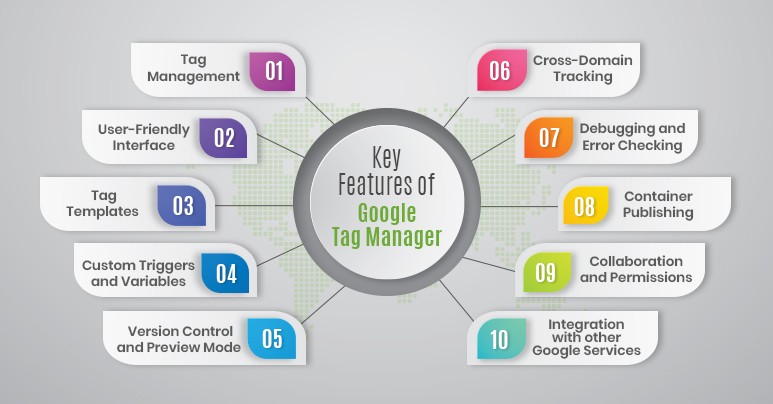Google Tag Manager (GTM) is a powerful tool offered by Google that allows you to manage and deploy various tracking tags and scripts on your website without the need for manual code implementation. Here are some key features of Google Tag Manager:
1. Tag Management: Google Tag Manager simplifies the process of adding and managing tags on your website. Instead of modifying the website's code directly, you can use GTM's web-based interface to add, edit, and remove tags.
2. User-Friendly Interface: GTM provides an intuitive and user-friendly interface, making it accessible to marketers and non-technical users. You can manage all your tags and configurations in one centralized location.
3. Tag Templates: GTM offers a wide range of pre-built tag templates for popular tracking and analytics tools, such as Google Analytics, Facebook Pixel, AdWords Conversion Tracking, and many others. These templates make it easier to set up tags without manually configuring each one.
4. Custom Triggers and Variables: GTM allows you to define custom triggers and variables to determine when and where your tags should be fired. Triggers specify the conditions under which tags are activated (e.g., page load, form submission, button click), while variables capture dynamic data to be used in tags (e.g., page URL, user ID).
5. Version Control and Preview Mode: GTM enables version control, allowing you to create and manage different versions of your tag configurations. You can easily roll back to a previous version if needed. The preview mode allows you to test and validate your tags before deploying them on your live website.
6. Cross-Domain Tracking: If you have multiple domains or subdomains, GTM facilitates cross-domain tracking. It simplifies the implementation of tracking codes across different sites and provides consolidated reports within your analytics tool.
7. Debugging and Error Checking: GTM includes built-in debugging tools that help identify issues with tags, triggers, and variables. You can preview and test your tags, monitor tag firing, and troubleshoot any errors or misconfigurations.
8. Container Publishing: Once you've configured your tags, triggers, and variables in GTM, you can publish them as a container, which generates a code snippet. This code snippet is then placed on every page of your website, and it takes care of loading and executing all the specified tags.
9. Collaboration and Permissions: GTM supports collaboration among team members. You can provide different access levels and permissions to individuals, allowing them to view, edit, or publish changes to the container.
10. Integration with other Google Services: GTM seamlessly integrates with other Google services like Google Analytics, Google Ads, and Google Optimize. It simplifies the implementation of tracking codes and conversion goals for these services.
Overall, Google Tag Manager streamlines the process of managing tracking tags on your website, reduces reliance on developers for tag implementation, and provides greater flexibility and control over your marketing and analytics tools.





